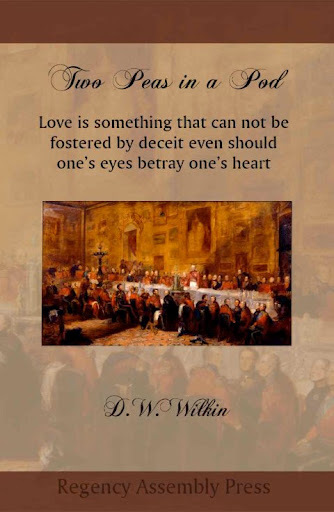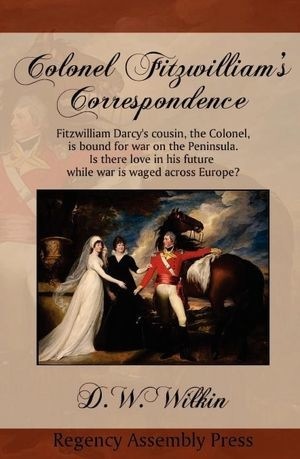D.W. Wilkin's Blog, page 49
June 3, 2016
Regency Personalities Series-Boulton and Watt
Regency Personalities Series
In my attempts to provide us with the details of the Regency, today I continue with one of the many period notables.
Boulton and Watt
1775-1895
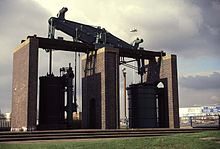
Boulton and Watt as an early British engineering and manufacturing firm in the business of designing and making marine and stationary steam engines. Founded in the English West Midlands around Birmingham in 1775 as a partnership between the English manufacturer Matthew Boulton and the Scottish engineer James Watt, the firm had a major role in the Industrial Revolution and grew to be a major producer of steam engines in the 19th century.
The partnership was formed in 1775 to exploit Watt’s patent for a steam engine with a separate condenser. This made much more efficient use of its fuel than the older Newcomen engine. Initially the business was based at the Soho Manufactory near Boulton’s Soho House on the southern edge of the then-rural parish of Handsworth. However most of the components for their engines were made by others, for example the cylinders by John Wilkinson.
In 1795, they began to make steam engines themselves at their Soho Foundry in Smethwick, near Birmingham, England. The partnership was passed to two of their sons in 1800. William Murdoch was made a partner of the firm in 1810, where he remained until his retirement 20 years later at the age of 76. The firm lasted over 120 years, albeit renamed “James Watt & Co.” in 1849, and was still making steam engines in 1895, when it was sold to W & T Avery Ltd..
The business was a hotbed for the nurturing of emerging engineering talent. Among the names which were employed there in the eighteenth century were James Law, Peter Ewart, William Brunton, Isaac Perrins, William Murdoch, and John Southern.
Smethwick Engine, Thinktank science museum, Birmingham, manufactured 1779.
Whitbread Engine, Powerhouse Museum, Sydney, manufactured 1785.
Crofton Pumping Station manufactured 1812.
Kew Bridge Steam Museum manufactured 1820.


Two Peas in A Pod, A Regency Romance
Two Peas in a Pod has now passed the exclusivity to Amazon test and is available in wider release, electronically (digitally) for other readers now. We sold a few copies on Amazon but nothing to warrant an exclusivity period. Amazon is too big and too full of itself.
Two Peas in a Pod is still available as a Trade paperback click here to order Regency Assembly Press.
$3.99 for an electronic copy. The Trade Paperback, due to publishing costs and the cut that Amazon takes continue to see a Trade Paperback costing $15.99 (The much hyped royalties that we writers are supposed to get is nowhere near what the news reports say. Most of that price is taken by Amazon.)
iBookstore (These are my books
and still at Amazon
Here is a picture, which of course you can click on to go fetch the book:
Love is something that can not be fostered by deceit even should one’s eyes betray one’s heart.
Two brothers that are so close in appearance that only a handful have ever been able to tell them apart. The Earl of Kent, Percival Francis Michael Coldwell is only older than his brother, Peregrine Maxim Frederick Coldwell by 17 minutes. They may have looked as each other, but that masked how they were truthfully quite opposite to one another.
For Percy, his personality was one that he was quite comfortable with and more than happy to let Perry be of a serious nature. At least until he met Veronica Hamilton, the daughter of Baron Hamilton of Leith. She was only interested in a man who was serious.
Once more, Peregrine is obliged to help his older brother by taking his place, that the Earl may woo the young lady who has captured his heart. That is, until there is one who captures Peregrine’s heart as well.
There is a visual guide to Two Peas in a Pod 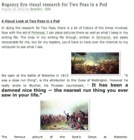 as well at Pinterest and a blog post here.
as well at Pinterest and a blog post here.


June 2, 2016
Regency Personalities Series-Thomas Maclear
Regency Personalities Series
In my attempts to provide us with the details of the Regency, today I continue with one of the many period notables.
Sir Thomas Maclear
17 March 1794 – 14 July 1879
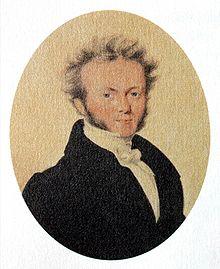
Thomas Maclear
Sir Thomas Maclear was born in Newtownstewart, County Tyrone, Ireland, the eldest son of Rev. James Maclear and Mary Magrath. In 1808 he was sent to England to be educated in the medical profession. After passing his examinations, in 1815 he was accepted into the Royal College of Surgeons of England. He then worked as house-surgeon in the Bedford Infirmary.
In 1823 he went into partnership with his uncle at Biggleswade, Bedfordshire. Two years later in 1825 he was married to Mary Pearse, the daughter of Theed Pearse, Clerk of the Peace for the county of Bedford.
Maclear had a keen interest in amateur astronomy, and would begin a long association with the Royal Astronomical Society, to which he would be named a Fellow. In 1833, when the post became vacant, he was named as Her Majesty’s Astronomer at the Cape of Good Hope, and arrived there aboard the Tam O’Shanter with his wife and 5 daughters, to take up his new duties in 1834. He worked with John Herschel until 1838, performing a survey of the southern sky, and continued to perform important astronomical observations over several more decades. The Maclears and Herschels formed a close friendship, the wives drawn together by the unusual occupations of their husbands and the raising of their large families. Mary Maclear, like Margaret Herschel, was a noted beauty and intelligent, though suffering from extreme deafness.
In 1750, Abbe Nicolas Louis de Lacaille had measured a triangulation meridian arc northwards from Cape Town, to determine the figure of the earth and found that the curvature of the earth was less in southern latitudes than at corresponding northern ones. Sir George Everest visited the Cape in 1820 and visited the site of LaCailles measurements. From his experience in the Himalayas he believed that the presence of considerable mountain masses in the Cape could have caused false measurements to be made by LaCaille. Between 1841 and 1848, Maclear would be occupied in performing a geodesic survey for the purpose of recalculating the dimensions and shape of the Earth. He became close friends with David Livingstone, and they shared a common interest in the exploration of Africa. He performed many other useful scientific activities, including collecting meteorological, magnetic and tide data.
In 1861 his wife died. Two years later he was granted a pension, but did not retire from the observatory until 1870. He lived thereafter at Grey Villa, Mowbray. By 1876, he had lost his sight, and he died three years later in Cape Town, South Africa. He is buried next to his wife on the grounds of the Royal Observatory.
Knighted in 1860 for his achievements as an astronomer.
Lalande Prize (1866)
Royal Medal of the Royal Society (1869), for his measurement of an arc of the meridian in the 1840s.
The crater Maclear on the Moon is named after him; as is Maclear’s Beacon on Table Mountain; the town of Maclear, in the Eastern Cape of South Africa; and Cape Maclear in Malawi, so named by his friend David Livingstone.


A Trolling we Will Go Omnibus: The first three Fantasy stories of Humphrey and Gwendolyn
A Trolling We Will Go Omnibus:The Early Years
Not only do I write Regency and Romance, but I also have delved into Fantasy.
The Trolling series, (the first three are in print) is the story of a man, Humphrey. We meet him as he has left youth and become a man with a man’s responsibilities.
We follow him in a series of stories that encompass the stages of life. We see him when he starts his family, when he has older sons and the father son dynamic is tested.
We see him when his children begin to marry and have children, and at the end of his life when those he has loved, and those who were his friends proceed him over the threshold into death.
All this while he serves a kingdom troubled by monsters. Troubles that he and his friends will learn to deal with and rectify.
Here are the first three books together as one longer novel.
A Trolling We Will Go, Trolling Down to Old Mah Wee and Trolling’s Pass and Present.
Available in a variety of formats.
For $6.99 you can get this fantasy adventure.
Barnes and Noble for your Nook
The stories of Humphrey and Gwendolyn. Published separately in: A Trolling we Will Go, Trolling Down to Old Mah Wee and Trollings Pass and Present.
These are the tales of how a simple Woodcutter and an overly educated girl help save the kingdom without a king from an ancient evil. Long forgotten is the way to fight the Trolls.
Beasts that breed faster than rabbits it seems, and when they decide to migrate to the lands of humans, their seeming invulnerability spell doom for all in the kingdom of Torahn. Not only Torahn but all the human kingdoms that border the great mountains that divide the continent.
Feedback
If you have any commentary, thoughts, ideas about the book (especially if you buy it, read it and like it
June 1, 2016
Regency Personalities Series-John Ebers
Regency Personalities Series
In my attempts to provide us with the details of the Regency, today I continue with one of the many period notables.
John Ebers
1778 – 8 December 1858
John Ebers was born in Hertford, and was baptised there at St. Andrew’s Church on 24 July 1778. Around 1810 he took over his father’s bookselling business at 27 Old Bond Street, He seems to have been commercially successful, as he is described, at the beginning of his career as a manager, as ‘an opulent bookseller in Bond Street, who has been largely engaged in the interests of the holders of property-boxes for some years’. From this it would seem that he had acted as a kind of ticket agent.
In 1820 the London season of Italian opera at the King’s Theatre had come to a premature end, after its director had fled the country leaving the orchestra unpaid. Ebers, who had lent money to the theatre and had the assignment of several of the opera’ s boxes as part of his ticket-selling business, took on the task of theatre management, but relied on his musical director, William Ayrton, to bring matters into a more satisfactory state.
At first Ebers became the lessee of the theatre for one year only, and on 10 March 1821 the house opened with La gazza ladra, the first time that it had been heard in England. As compared with the former seasons, this year was eminently successful, although it seems to have been the general opinion that the manager’s promises with regard to the excellence of the singers had not been fulfilled. Violante Camporese, who appeared as Donna Anna in Don Giovanni with the greatest success, had been engaged at a salary of 1,550l. Giuseppina Ronzi de Begnis, her husband, the bass Giuseppe de Begnis, and Alberico Curioni seem to have been the only other singers whose performances gave unmingled satisfaction. Rossini’s Il turco in Italia was the only other novelty produced during the season; but in spite of this somewhat modest inauguration of his management, Ebers seems to have been commercially successful.
In 1822, Ebers ventured to take a four years’ lease of the theatre from a banker named Chambers, who owned the theatre at the time. Ayrton seems to have been uniformly unfortunate in his relations with managers, for the connection between him and Ebers was dissolved that year. A Signor Petracchi, conductor at La Scala, Milan, was summoned to succeed him, and a board of directors, consisting of various noblemen, was associated with the management of the undertaking. The strength of the company was increased by the addition of Maria Caterina Rosalbina Caradori-Allan and Pierre Begrez. The productions of the year were Rossini’s Pietro l’eremita (i.e. Mosè in Egitto) and Otello, Giuseppe Mosca’s I pretendenti delusi, and Giovanni Pacini’s Il barone di Dolsheim, both of which last failed. In spite of this, the season was on the whole successful. In 1823 the management was placed in the hands of a committee, under a certain guarantee to Ebers. Rossini’s La donna del lago, Ricciardo e Zoraide, Matilde di Shabran and Saverio Mercadante’s Elisa e Claudio were produced. Although the bad accounts of the season which are to be read in the ‘Harmonicon’ for 1823 must be taken with a grain of salt (Ayrton was the editor of the paper, which appeared first in that year), it is still to be perceived that the affairs of the theatre were in an unsatisfactory state. Lucia Elizabeth Vestris was the only addition to the company, and Violante Camporese retired at the end of the season.
Ebers now sublet the theatre for two years to Giovanni Battista Benelli, who had been assistant stage manager. In January 1824 the season opened with Rossini’s Zelmira with Isabella Colbran in the principal part, the composer himself being advertised to be present. He had undertaken to write an opera, Ugo, re d’Italia, but it was never finished. Pasta made her appearance on 24 April, and the season lasted, in spite of enormous losses, until 14 August, shortly after which Benelli decamped, leaving Rossini and the artists unpaid. The matter came before the courts, with Ebers appealing to the Lord Chancellor to put him again into the management of the theatre. The particulars of the actions may be read in the ‘Quarterly Musical Magazine,’ vi. 516–521. It was generally considered that the engagement of Rossini was unwise; but the patronage bestowed by the fashionable world had been so great that Ebers felt justified in announcing a new season, returning again to the directorship of Ayrton. The fact that the leases of the ‘property-boxes’ were to fall in at the end of 1825 gave a prospect of success. His prospectus is more or less apologetic, but he had secured the services of a fairly good company, and in the course of the season Pasta was prevailed on to accept a portion of the salary due to her from the previous year in lieu of the whole amount, and to return to London.
The board of works declaring the King’s Theatre to be unsafe, the Haymarket Theatre was taken for a time, from the beginning of March until the middle of April. Rossini’s Semiramide was brought out on 20 June, and Giacomo Meyerbeer’s Il crociato in Egitto on 23 July, for the first appearance of Giovanni Velluti, the castrato, who was one of the great attractions of the year. At the end of the season Ayrton again retired, possibly on account of a difficulty which the management had had with Manuel García, the correspondence relating to which is published in the ‘Quarterly Musical Magazine,’ vii. 188–91. In November, Velluti was appointed director, and the new season was announced to begin on the last day of the old year. It began on 7 January 1826, when great dissatisfaction was caused by the substitution of many inexperienced orchestral performers for those who had played for many seasons. Francesco Morlacchi’s Tebaldo ed Isolina was produced without success on 25 February. In May Pasta appeared, and drew large audiences. Velluti’s voice began to give out at the end of the season, and Ebers’s choice of Rossini’s Aureliano in Palmira for his benefit, 22 June, did not add to his popularity. He got into trouble concerning the pay to the chorus on this occasion, and the matter was decided against him in the sheriff’s court. On 12 August the season came to an abrupt end, several performances being still due. In the next season Carlo Coccia, the conductor, resigned his post, and after considerable difficulty his place was taken by Nicolas-Charles Bochsa, who had undertaken two seasons of oratorios at the King’s Theatre without any success, was now appointed director, and on 2 December the house opened with Gasparo Spontini’s La vestale. Pacini’s La schiava in Bagdad and Coccia’s Maria Stuarda were produced, and on 7 August the theatre again closed prematurely. At the end of the year Ebers, being unable to pay the enormous rent demanded of him by the assignees of Chambers, became a bankrupt.
In 1826, the young Harrison Ainsworth, having qualified as a lawyer, joined Ebers’s bookselling business as a partner. Ebers had earlier published Ainsworth’s first novel (Sir John Chiverton, written in collaboration with J. Ashton). In October 1826 Ainsworth married Ebers’s daughter Anne Frances (Fanny), and the couple moved in with Ebers. Ainsworth almost certainly assisted Ebers in writing his memoirs , Seven Years of the Kings Theatre (1828). However he quit his business partnership with Ebers in 1829.
Messrs. Chambers at first intended to carry on the undertaking themselves, but they ultimately let the theatre to a certain Laurent, who was also lessee of the Théâtre Italien in Paris. After a year he was succeeded by Pierre François Laporte. In 1828 Ebers published his Seven Years of the King’s Theatre, a book put together with some skill, and in its way an entertaining history of his career. He lays before the public all his accounts, in order to justify his own position, and on the whole it must be admitted to be a valuable contribution to the history of the Italian opera in England. After his failure as a manager, he resumed his business as a bookseller and stationer. His name appears in the directories as the proprietor of the business at 27 Old Bond Street down to 1830; in 1831 the style is John Ebers & Co., and from 1836 onwards the name is given as S. Ebers & Co. An Emily S. Ebers, who may have been his daughter, carried on the business, being called in the directory ‘opera agent,’ until 1863.
Ebers died on 8 December 1858 in Kensington, London, and was buried in Kensal Green Cemetery.


A Jane Austen Sequel: Colonel Fitzwilliam’s Correspondence
Colonel Fitzwilliam’s Correspondence For your enjoyment, one of the Regency Romances I published.
It is available for sale and I hope that you will take the opportunity to order your copy.
For yourself or as a gift. It is now available in a variety of formats.
For just a few dollars this Regency Romance can be yours for your eReaders or physically in Trade Paperback.
Visit the dedicated Website
Barnes and Noble for your Nook or in Paperback
Amazon for your Kindle or in Trade Paperback
Witnessing his cousin marry for love and not money, as he felt destined to do, Colonel Fitzwilliam refused to himself to be jealous. He did not expect his acquaintance with the Bennet Clan to change that.
Catherine Bennet, often called Kitty, had not given a great deal of thought to how her life might change with her sisters Elizabeth and Jane becoming wed to rich and connected men. Certainly meeting Darcy’s handsome cousin, a Colonel, did not affect her.
But one had to admit that the connections of the Bingleys and Darcys were quite advantageous. All sorts of men desired introductions now that she had such wealthy new brothers.
Kitty knew that Lydia may have thought herself fortunate when she had married Wickham, the first Bennet daughter to wed. Kitty, though, knew that true fortune had come to her. She just wasn’t sure how best to apply herself.
Feedback
If you have any commentary, thoughts, ideas about the book (especially if you buy it, read it and like it
May 31, 2016
Regency Personalities Series-John Ponsonby 4th Earl of Bessborough
Regency Personalities Series
In my attempts to provide us with the details of the Regency, today I continue with one of the many period notables.
John William Ponsonby 4th Earl of Bessborough
531 August 1781 – 16 May 1847

John William Ponsonby
John Ponsonby 4th Earl of Bessborough was the eldest son of Frederick Ponsonby, 3rd Earl of Bessborough, and Lady Henrietta Frances, daughter of John Spencer, 1st Earl Spencer. Sir Frederick Cavendish Ponsonby and William Ponsonby, 1st Baron de Mauley, were his younger brothers, while Lady Caroline Lamb was his younger sister. Ponsonby’s mother was Lord Granville’s lover prior to his marriage to Lady Harriet Cavendish, the Countess of Bessborough’s niece. Lord Granville fathered two illegitimate children through her: Harriette Stewart and George Stewart. Lord Bessborough was educated at Harrow and Christ Church, Oxford.
He was First Commissioner of Woods and Forests under Lord Grey (1831–1834) and served under Lord Melbourne in that office (1835-1841), briefly as Home Secretary (1834), and as Lord Privy Seal (1835–1839). Later, he served as Lord Lieutenant of Ireland under Lord John Russell from 1846 until his death on 16 May 1847. He was made a Privy Counsellor in 1831 and in 1834, ten years before he succeeded his father, he was created Baron Duncannon, of Bessborough in the County of Kilkenny. He was Lord Lieutenant of Kilkenny from November 1838 until his death.
His political career was hampered by a noted stammer, which made him a very reluctant public speaker: as Lord Duncannon he was unkindly nicknamed “Dumbcannon”. In private on the other hand he was a valued colleague, due largely to his ability to keep his head in a crisis. He was one of the so-called Committee of Four who drafted the Reform Act 1832.
John Ponsonby married Lady Maria Fane, daughter of John Fane, 10th Earl of Westmorland, and Sarah Anne Child, on 16 November 1805 at Berkeley Square, London. They had eight sons and three daughters. The youngest daughter, Emily Charlotte Mary, remained unmarried but she wrote a number of novels which were published without attribution. The Countess of Bessborough died in March 1834, aged 46. Lord Bessborough survived her by thirteen years and died in May 1847, aged 65. He was succeeded in the earldom by his eldest son, John, and subsequently by his younger sons Frederick and Walter. Bessborough Gardens in London is named after Lord Bessborough.


Beaux, Ballrooms, and Battles
A new Regency Anthology
Beaux, Ballrooms, and Battles anthology, celebrating the 200th anniversary of the victory at Waterloo in story.
Looks good, huh? The talented writer and digital artist, Aileen Fish created this.
It will be available digitally for $.99 and then after a short period of time sell for the regular price of $4.99
The Trade Paperback version will sell for $12.99
Click on the Amazon Link—>Amazon US

My story in the anthology is entitled: Not a Close Run Thing at All, which of course is a play on the famous misquote attributed to Arthur Wellesley, “a damn close-run thing” which really was “It has been a damned nice thing — the nearest run thing you ever saw in your life.”
Samantha, Lady Worcester had thought love was over for her, much like the war should have been. The Bastille had fallen shortly after she had been born. Her entire life the French and their Revolution had affected her and all whom she knew. Even to having determined who she married, though her husband now had been dead and buried these eight years.
Yet now Robert Barnes, a major-general in command of one of Wellington’s brigades, had appeared before her, years since he had been forgotten and dismissed. The man she had once loved, but because he had only been a captain with no fortune, her father had shown him the door.
With a battle at hand, she could not let down the defenses that surrounded her heart. Could she?
As her father’s hostess, she had travelled with him to Brussels where he served with the British delegation. Duty had taken her that night to the Duchess of Richmond’s ball. The last man she ever expected to see was Robert, who as a young captain of few prospects, had offered for her, only to be turned out by her father so that she could make an alliance with a much older, and better positioned (wealthy), aristocrat.Now, their forces were sure to engage Napoleon and the resurgent Grande Armée. Meeting Robert again just before he was to be pulled into such a horrific maelstrom surely was Fate’s cruelest trick ever. A fate her heart could not possibly withstand.
Here are the first few paragraphs to entice you:
Chapter One
“Come father, we shall be dreadfully late. Already the other guests of the inn have all departed for the ball.” Samantha distinctly heard him grunt. Her father did not like balls.
“You will not fault me if I stay to the card room with the other old gentlemen. We always have much to discuss,” he said. Her father served with the delegation led by Sir Charles Stuart.
In a moment he would complain about the pains caused by his gout. Always handy when social obligations were required and never present when he had his ‘important’ work to do.
“Father, are you sure that there is going to be a battle? I just can’t believe that Her Grace of Richmond is hosting a ball when the soldiers will be going off to fight.” Lady Worcester, who had been once just The Honourable Samantha Villiers, asked of her father, the second Viscount Haddington.
She had married the Earl of Worcester twelve years before, a man who had died before the Peace of Amiens had been shattered. They had no children, and as there were only distant heirs, the property went to those relations whilst the title became extinct. Samantha was the last Lady Worcester.
“The fighting is close at hand, but I have every confidence in the Duke of Wellington. Marvellous man. The French will be quite surprised when he takes this army and invades their lands,” her father said. “I am afraid I shall not be able to stand up and offer one dance with you, my good girl. The pains in my foot are troubling me.”
As Samantha had predicted.
That was always the excuse. Samantha was assured that her father had not once stood up to dance since her mother had died.
Over the many years she had had to study her father, for she had taken to being the hostess of his household upon the death of her husband, her mother having died before her own marriage, she had noted that her father was more impressed by title, position, and wealth, than by capabilities.
However, her own study of Wellesley, now the Duke, paralleled her father’s assessment at least when it came to Wellington’s successes as a commander. Yet the Duke had never faced Napoleon. Until only the most recent years, the Emperor of France had seldom lost any engagement. The Duke of Wellington had faced Napoleon’s lieutenants, and captains, but never the very best commanders of Le Grande Armée.
“It is understandable, Father, with your foot being troublesome, that you wish to proceed to the card room. You should enjoy this night. It will all be over too soon, and as you say, the engagement is imminent. Many here this evening we may never know again.” More than twenty years of war and she had known the loss of several military men.
Her father nodded. He had trained her to recognize the truth regarding these years of war. It was why he had been so against a liaison with Robert Barnes when she had first come out. Her other ardent suitor during her Season in ’03.
A time long ago.
Samantha and the Viscount were in the foyer of their lodgings. All the best places had been taken by those of great rank and wealth. This was a small inn that six other families shared.
She and her father were ready to leave for the ball, their hired carriage at the front of the building even then. Samantha had looked from the window and seen their coachman, Phillipe, waiting patiently.
He was paid for from her Worcester monies. The two years that Samantha had not lived with her father whilst married, had resulted in his losing near all the Haddington monies. He had retained very little of the capital, none of grandfather’s lands, and survived on monies advanced by the government to see to his office as well as what monies Lady Worcester was able to provide to the expenses of his household. Expenses that she managed with prudence.
Shaking her head and exiling the thought away, she pondered on a ball in a coach house. How novel to attend.
She had called on the Duchess several times, as they knew each other socially. Samantha well knew many of the women that had formed society here in Brussels. Her father’s stature with the delegation caused her to be a hostess to much smaller events than the ball.
With the assured defeat of Napoleon the war would end and her father’s service would be over. So also would the service of that other man who had asked for her before.
Robert had gone back to fight once war broke out again when the Peace of Amiens fell apart. She had since lost track of him.
Samantha had forced herself to lose track of him.


May 30, 2016
Regency Personalities Series-John Scott (Editor)
Regency Personalities Series
In my attempts to provide us with the details of the Regency, today I continue with one of the many period notables.
John Scott (Editor)
24 October 1784 – 27 February 1821
John Scott edited several liberal newspapers: The Statesman, which Leigh Hunt founded; the Stamford News, published by John Drakard; Drakard’s Paper (a London edition of this), which he renamed The Champion; and the most notable, the London Magazine, which he revived, as a monthly, in January 1820.
Under his direction, the magazine included works by such luminaries as Wordsworth, Charles Lamb, de Quincey, John Clare, Thomas Hood, Carlyle, Keats, Leigh Hunt, and Hazlitt. He also agreed to write a third of the magazine himself, which he did mostly under pseudonyms.
He attended Aberdeen Grammar School, as did Lord Byron, who was some years younger; he spent 1795-8 at Marischal College, but left without graduating. When Byron published an account of his marriage in 1816, Scott called this publication indelicacy; Leigh Hunt quarreled with him over this.
He died as the result of a duel, one of the side effects of the Cockney School controversy. John Gibson Lockhart had been abusing many of Scott’s contributors in Blackwood’s Magazine (under a pseudonym (Z), as was then common). In May 1820, Scott began a series of counter-articles, which provoked Lockhart into calling him “a liar and a scoundrel”. In February 1820, Lockhart’s London agent, Jonathan Henry Christie, made a provocative statement, and Scott challenged him.
They met on 16 February 1821, at a farm between Camden Town and Hampstead. Christie did not fire in the first round, but there was a misunderstanding between the seconds, resulting in a second round. Scott was hit in the abdomen, and died 11 days later. Christie and his second were tried for wilful murder and acquitted; the collection for Scott’s family was a notable radical cause.


1st book in the Masqueraders Chocolate House series
I and five others have released the first in what could turn out to be a few, an anthology centered around Bath of the Georgian and Regency period. All proceeds go to charity, specifically the Great Ormond Street Hospital.
The Chocolate House
All For Love
[image error]
Our Authors are noted and award winning storytellers in the genre of Georgian and Regency era Historical Novels:
David W Wilkin
Francine Howarth
Giselle Marks
Jessica Schira
Susan Ruth
Elizabeth Bailey
A Sensual blend of Chocolate, Romance, Murder & Mystery at “Masqueraders”.
The beautiful City of Bath, famous for its Roman Spa, its Abbey, its Pump Room & Assembly Rooms, and Sally Lunn’s bun shop, is a place made famous within the literary world by the likes of Jane Austen, Georgette Heyer, and other authors of Georgian and Regency historical novels. Thus Bath is renowned as a place for intrigue and romance, but few readers will have stepped across the threshold of Masqueraders’, a notorious and fashionable Chocolate House, that existed within the city from 1700 to the latter part of the reign of William IV. What happened to it thereafter, no one knows, for sure. Nor does anyone know why Sally Lunn’s bun shop disappeared for decades until it was rediscovered.
So it could be said, essence of chocolate drifting on the ether denotes where the seemingly mystical Masqueraders’ once existed, and it is that spiritual essence that has brought authors together from around the globe, to pen a delightful collection of Georgian & Regency romances, that are, all, in some way, linked to The Chocolate House. We sincerely hope you will enjoy the individual stories, and be assured all the royalties earned will be donated to Great Ormond Street Hospital for Children, London.
The stories:
A Rose by Any Other – Giselle Marks.
A Fatal Connection – Elizabeth Bailey
The Runaway Duchess – Francine Howarth
Death at the Chocolate House – Susan Ruth
A-Pig-in-a-Poke – Jessica Schira
A Little Chocolate in the Morning – David W. Wilkin.
My story (As the author and owner of this Blog, I feel I can tell you more) is the story of Charles Watkins the Marquis of Rockford (for those who want the nitty gritty, ask and we can discuss the very specific creation of name details that went into this) who has recently come into his title and estates, his father dying just about a year before. Now he is to return to London after his mourning is over to use his seat in the House of Lords in aid of the war against Napoleon. He is not in Town to seek a bride though the dowager Marchioness should like that he attain one.
No, certainly not the schoolmate of his younger sister Emma, Lady Caroline Williamson, the daughter of the Earl of Feversham. A girl as young and silly as his sister, he would never wed, and certainly not fall in love with. But rescuing her from the clutches of a man who was old enough to be his own grandfather, that he could do with ease, and perhaps Panache.
Available at Amazon Digitally for your Kindle for $2.99 or Physically in Trade Paperback



